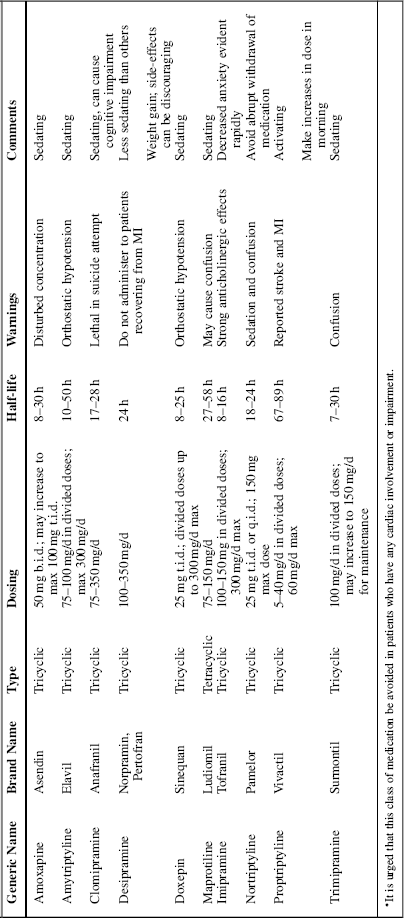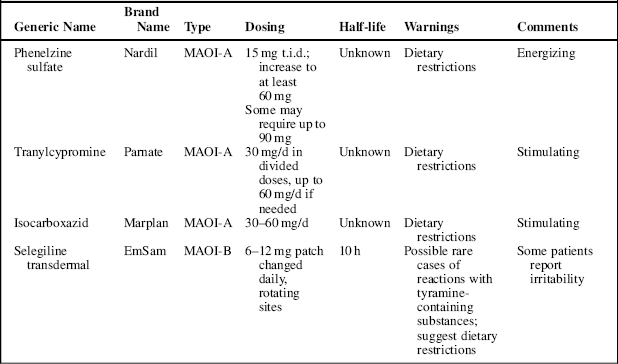34.1 Introduction
The fourth edition of Diagnostic and Statistical Manual of Mental Disorders, text revision, categorizes mood disorders into depressive disorders (unipolar depression) and bipolar disorders (see Chapters 13 and 14). The two major subclasses of medications for the treatment of mood disorders are antidepressants and mood stabilizers. The antidepressants are also first-line treatments for anxiety disorders (see Chapter 15). This chapter discusses the major antidepressants and mood stabilizers in current use.
The term “antidepressant” is something of a misnomer as medications used to treat mood disorders can also be used to treat the anxiety disorders, as well as pain conditions. Indeed the selective serotonin-reuptake inhibitor class of antidepressant medications is the treatment of choice for most of the anxiety disorders and obsessive–compulsive disorder. In depressive disorders, antidepressant medications are employed to alleviate symptoms such as dysphoric mood, changes in appetite and energy levels, anhedonia, feelings of hopelessness, suicidal ideation, concentration problems, and others.
Antidepressant medications are divided into a number of categories that describe their mode of action. Commonly prescribed antidepressant medications, with their generic and trade names, common dosages, modes of action, and half-lives will be covered here.
34.2.1 The Tricyclic and Tetracyclic Group
Developed in the 1960s, these drugs were the medications first used to combat major depressive disorders, and they were the early precursors to the newer selective serotonin-reuptake inhibitors. They are listed in Table 34.1.
Table 34.1 Tricyclic and tetracyclic antidepressants*

The TCAs inhibit the neuronal uptake of both serotonin and norepinephrine and have high anticholinergic properties, which can be peripheral or central. Some of these properties are listed in Box 34.1. Clinicians should be attuned to these effects as they can be debilitating, especially in susceptible patients such as the elderly.
Box 34.1 Potential Adverse Effects of Medications with Anticholinergic Properties
| SERIOUS |
| Delirium |
| Vertigo |
| Respiratory problems or changes |
| Convulsions |
| Fever |
| Increased heart rate |
| Increased blood pressure |
| Visual impairment (eye pain, changes in acuity, blurriness, worsening of glaucoma) |
| Urinary retention |
| Mental status changes (cognitive decline, confusion or disorientation, hallucinations, memory loss, distress or excitement) |
| MINOR |
| Headache |
| Muscle weakness |
| Urinary hesitancy |
| Light sensitivity |
| Drowsiness |
| Digestive system changes (bloating, decreased bowel motility, constipation, ileus, nausea or vomiting, dry mouth or nose, dry mucus membranes) |
| Slurring of speech |
| Lethargy or fatigue |
| Dryness or flushing of skin |
| Decreased sweating |
As a rule, the more sedating the TCA, the more anticholinergic properties it will have. Ways to control side-effects from TCAs include starting the patient with a low dose and raising the dose slowly, or changing to another antidepressant with less problematic side-effects. Patients taking TCAs frequently do not experience clinical effects for 2–6 weeks because of the secondary messaging system, so they require support and encouragement to get through this time of adjustment.
TCAs should be carefully distributed to suicidal patients, given the high risk and lethality of overdose. The most drastic consequence of this class of medications is the danger that they pose as lethal agents of suicide. Taken together, a 10-day supply of these medications may cause cardiac and cerebral toxicity. With patients beginning antidepressant medication therapy, a good rule of thumb is to limit the amount of medication prescribed at any one time. Moreover, patients beginning any antidepressant therapy should be carefully monitored because research indicates that risk for suicide increases when patients begin to “feel better” or energized.
When TCAs are given in conjunction with oral anticoagulants, patients may be at risk for bleeding. Administration with clonidine may cause severe hypertension. Although monoamine oxidase inhibitors and TCAs can be used together to successfully treat refractory depression, severe adverse reactions (including hyperpyretic crises and hypertensive episodes) may occur.
34.2.2 Selective Reuptake Inhibitors
These represent the newest class of drugs used to treat depression and anxiety disorders. They are sometimes called the second-generation antidepressants. These medications target the reuptake of serotonin only (SSRIs); dopamine, norepinephrine, or both (SRIs); or norepinephrine only (SNRIs). The medications in each class are structurally different, so people taking these medications will respond better to one than another. Table 34.2 includes these classes of medications.
Table 34.2 Second-generation antidepressants.


SSRIs immediately block neuronal transport of serotonin. This blockage stimulates many postsynaptic receptor sites, which probably contributes to the side-effects associated with these drugs. Side-effects include nausea, vomiting, weight loss or gain, and delayed or impaired orgasm. These drugs also may cause agitation or restlessness.
Because these medications have a more tolerable side-effect profile, pose no risk for lethal overdose, and are effective in 70% of cases, they are now the first choice for treating depression. Unfortunately, many individuals complain that these drugs interfere with sexual performance, response, and arousal, a drawback that can affect medication compliance or adherence. The antidepressant response to SSRIs, like TCAs, may take 3–8 weeks. In some cases, a response takes as long as 3 months. Clinicians should explain carefully the need for an adequate medication trial to people beginning this drug therapy and engage family support which may be crucial for the patient who is suffering while waiting for a therapeutic response. They should also avoid ingestion of alcohol and should be counseled to check with their clinicians prior to starting any other medication, whether over the counter or prescription. Cigarette smoking decreases the effectiveness of this class of medications.
Side-effects of the antidepressants occur immediately and can be minimized by beginning with a subtherapeutic dose to improve initial tolerance according to some clinicians, while others opine that the starting dose is usually the same as the maintenance dose. Side-effects of this class of medication appear in Box 34.2.
Box 34.2 Side-Effects of Second-Generation Antidepressants
| SERIOUS |
| Drowsiness or confusion |
| Feelings of dread, panic or doom |
| Increase in suicidal ideation |
| Loss of libido, anorgasmia |
| Nervousness, agitation |
| Weight gain |
| MINOR OR SHORT-LIVED |
| Diarrhea |
| Vertigo |
| Dry mouth |
| Headache |
| Nausea |
| Sweating |
| Tremors |
34.2.3 Monoamine Oxidase Inhibitors
The MAOIs are a class of drug that inhibit monamine oxidase A (MAO-A), an enzyme that breaks down amines epinephrine, norepinephrine, and serotonin (Table 34.3). As amines are hypothesized to be deficient in depression, it is thought that this inhibitory effect is responsible for the clinical efficacy of MAOIs as antidepressants. MAOIs are used to treat atypical forms of depression or are prescribed for patients who are unresponsive to other antidepressant regimens. Their use has been replaced largely by the SSRIs.
Table 34.3 Monoamine oxidase inhibitors.

Side-effects of MAOIs include dizziness, vertigo, headache, overactivity, manic-like behavior, constipation, diarrhea, and nausea. In addition to breaking down amines, MAOIs breaks down tyramine, so dietary restrictions are necessary. The most serious risk of MAOI breakdown of tyramine involves hypertensive crises. Examples of foods that should be avoided include dairy products (especially aged cheese), meats (especially processed), and fish (dried, processed, or fermented). Beer, red wine, and certain fruits and vegetables (avocado, figs, raisins, and bananas) are other foods containing significant amounts of tyramine.
A recent edition to the MAOI armamentarium is the MAOI-B transdermal patch, selegiline, that bypasses the gut. When seligiline was introduced it was marketed as the “dietary-free MAOI,” but there have been some rare reports of a kind of hypertensive crisis in some individuals that is hypothesized to have been tyramine-related.
34.2.4 A Note on Serotonin Toxicity
Stay updated, free articles. Join our Telegram channel

Full access? Get Clinical Tree




